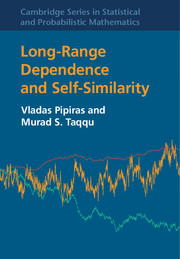Book contents
- Frontmatter
- Dedication
- Contents
- Expanded Contents
- List of Abbreviations
- Notation
- Preface
- 1 A Brief Overview of Time Series and Stochastic Processes
- 2 Basics of Long-Range Dependence and Self-Similarity
- 3 Physical Models for Long-Range Dependence and Self-Similarity
- 4 Hermite Processes
- 5 Non-Central and Central Limit Theorems
- 6 Fractional Calculus and Integration of Deterministic Functions with Respect to FBM
- 7 Stochastic Integration with Respect to Fractional Brownian Motion
- 8 Series Representations of Fractional Brownian Motion
- 9 Multidimensional Models
- 10 Maximum Likelihood Estimation Methods
- Appendix A Auxiliary Notions and Results
- Appendix B Integrals with Respect to Random Measures
- Appendix C Basics of Malliavin Calculus
- Appendix D Other Notes and Topics
- Bibliography
- Index
3 - Physical Models for Long-Range Dependence and Self-Similarity
Published online by Cambridge University Press: 11 May 2017
- Frontmatter
- Dedication
- Contents
- Expanded Contents
- List of Abbreviations
- Notation
- Preface
- 1 A Brief Overview of Time Series and Stochastic Processes
- 2 Basics of Long-Range Dependence and Self-Similarity
- 3 Physical Models for Long-Range Dependence and Self-Similarity
- 4 Hermite Processes
- 5 Non-Central and Central Limit Theorems
- 6 Fractional Calculus and Integration of Deterministic Functions with Respect to FBM
- 7 Stochastic Integration with Respect to Fractional Brownian Motion
- 8 Series Representations of Fractional Brownian Motion
- 9 Multidimensional Models
- 10 Maximum Likelihood Estimation Methods
- Appendix A Auxiliary Notions and Results
- Appendix B Integrals with Respect to Random Measures
- Appendix C Basics of Malliavin Calculus
- Appendix D Other Notes and Topics
- Bibliography
- Index
Summary
In this chapter, we present a number of physical models for long-range dependence and self-similarity. What do we mean by “physical models” for long-range dependence? First, models motivated by a real-life (physical) application. Second, though these models lead to long-range dependence, they are formulated by using other principles (than long-range dependence). One of these principles is often “responsible” for the emergence of long-range dependence. For example, the infinite source Poisson model discussed in Section 3.3 below, may model an aggregate traffic of data packets on a given link in the Internet. For this particular model, long-range dependence arises from the assumed heavy tails of workload distribution for individual arrivals. We consider the following models:
• Aggregation of short-range dependent series (Section 3.1)
• Mixture of correlated random walks (Section 3.2)
• Infinite source Poisson model with heavy tails (Section 3.3)
• Power-law shot noise model (Section 3.4)
• Hierarchical model (Section 3.5)
• Regime switching (Section 3.6)
• Elastic collision of particles (Section 3.7)
• Motion of a tagged particle in a simple symmetric exclusion model (Section 3.8)
• Power-law Pólya's urn (Section 3.9)
• Random walk in random scenery (Section 3.10)
• Two-dimensional Ising model (Section 3.11)
• Stochastic heat equation (Section 3.12)
• The Weierstrass function connection (Section 3.13)
Having physical models for long-range dependence is appealing and useful for a number of reasons. For example, in such applications, the use of long-range dependent models is then justified and thus more commonly accepted. In such applications, the parameters of long-range dependence models may carry a physical meaning. For example, in the infinite source Poisson model, the long-range dependence parameter is expressed through the exponent of a heavy-tailed distribution.
Aggregation of Short-Range Dependent Series
One way long-range dependence arises is through aggregation of short-range dependent (SRD) series. We focus here on aggregation of AR(1) series only, which is one of the simplest examples of SRD series and which has attracted most attention in the literature on aggregation.
Let a be a random variable supported on (−1, 1) and having a distribution function Fa. Suppose that a(j), j ≥ 1, are i.i.d. copies of a.
- Type
- Chapter
- Information
- Long-Range Dependence and Self-Similarity , pp. 113 - 228Publisher: Cambridge University PressPrint publication year: 2017



